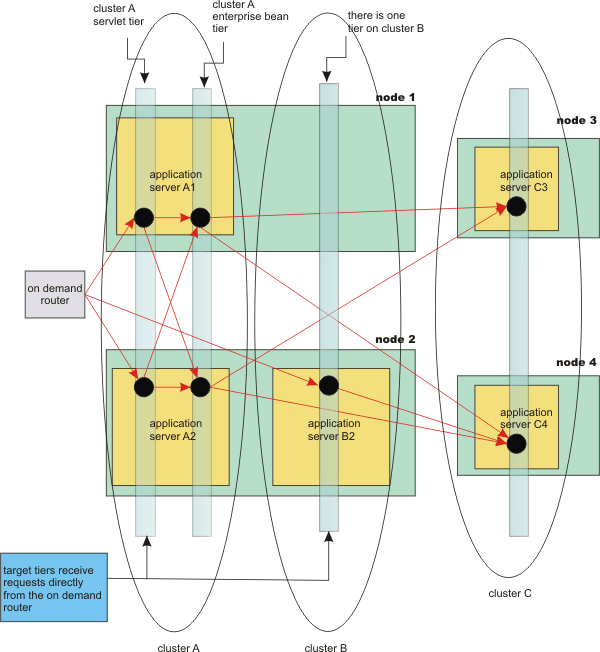Multiple tiers of processing
The autonomic request flow manager (ARFM) can process requests in multiple tiers. The tiers might include both WebSphere Application Server software and other software.
In a configuration that has multiple tiers, it is assumed that all of the software is organized into nodes, server processes or application servers, server process clusters, deployment targets, which can include both clusters and server processes that are not clustered, and processing tiers. Fore more information about servers and clusters that are not running WebSphere software, read about Intelligent Management topology terminology.
Figure 1. Multiple tiers of processing

In the preceding diagram, there are four nodes that have application servers that are members of a cluster. Each application server has one or more areas of processing, represented by black circles in the diagram.
Cluster A is made of WAS application servers. Server A1 and server A2 are both members of the cluster. Servlets and enterprise beans are deployed on the cluster. The servlets send work to the enterprise beans.
Each tier is specific to one deployment target. There are two tiers in cluster A. Cluster B and cluster C have one tier each. The servlet tier in cluster A and the only tier in cluster B are target tiers. A target server, target node, target cluster, target cell, or target tier receives requests directly from the on demand router (ODR).
The ARFM applies control at the entry to the system. In this case, the entry is the ODR. The ARFM does not measure traffic to or from tiers that are any deeper than the first tier. We must explicitly configure non-target tiers.
Restriction: The work profiler cannot determine good work factors when a node hosts both target and non-target tiers. The ARFM sends the application placement controller speed requests for the target clusters only. Each target cluster should have only one processing tier and should run on nodes that host target clusters only. Other nodes in the configuration can host non-target clusters that each contain multiple tiers.
For more information about configuring multiple tier configurations, read about routing requests to nodes that are not running Intelligent Management.
Related tasks